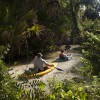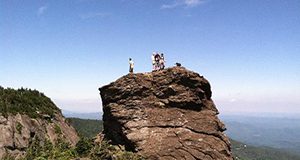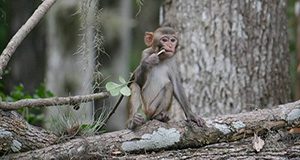Trails represent a landowner’s main routes for recreational activities such as walking, sightseeing, horseback riding, and bicycling. They provide access to, and through, forest land and other natural resources. They play an important role in protecting and preserving soil, water, and wild plants and animals. They can be the source of endless hours of enjoyment and relaxation. This 13-page fact sheet written by Alan Long, Anne Todd-Bockarie, Taylor Stein, Keith Bettcher, and Chris Demers and published by the School of Forest Resources and Conservation will help you plan your trails wisely and construct them carefully so that you and your guests can enjoy them to the fullest.
http://edis.ifas.ufl.edu/fr401
Tag: Ecotourism
History and Status of Introduced Rhesus Macaques (Macaca mulatta) in Silver Springs State Park, Florida
Local folklore suggests that the rhesus macaque monkeys living in what is today Silver Springs State Park were released while the 1939 movie Tarzan "Finds a Son" was filmed at the site, but no rhesus macaques appear in that movie, and the macaques had been living in Silver Springs for a considerable time before Tarzan found his son there. In fact, today’s thriving population of macaques in Silver Springs State Park descended from monkeys intentionally released earlier in the 1930s in an effort to increase tourism to the area.
Silver Springs became a tourist attraction in the 1870s and has had glass-bottom boat tours ever since. In the 1930s the manager of the glass bottom boat operation, Colonel Tooey, released approximately six rhesus macaques to attract tourists and increase revenue for the boat tours. Not knowing rhesus macaques are proficient swimmers, Colonel Tooey released his monkeys on an island in the Silver River from whence they quickly swam to the surrounding forests, where they made themselves at home and set up a growing colony. What happened next? Learn the story (so far!) of the monkeys and the park in this 4-page fact sheet written by C. J. Anderson, S. A. Johnson, M. E. Hostetler, and M. G. Summers and published by the Department of Wildlife Ecology and Conservation.
edis.ifas.ufl.edu/uw412
Valuing the Recreation Uses of Natural Resources: The Travel Cost Method
 Many available statistics provide evidence that outdoor recreation in Florida generates economic value, but these data do not capture the full recreation value of Florida’s natural resources. The Travel Cost Method (TCM) approach may be applied in cost-benefit analysis and in natural resource damage assessments where recreation values are relevant. This 8-page fact sheet summarizes and synthesizes economic texts on TCM and provides an overview of a case study in which the TCM was used to estimate the nature-based recreation use value of the Apalachicola River Region in Florida. Written by Elizabeth F. Pienaar, and published by the UF Department of Wildlife Ecology and Conservation, January 2014.
Many available statistics provide evidence that outdoor recreation in Florida generates economic value, but these data do not capture the full recreation value of Florida’s natural resources. The Travel Cost Method (TCM) approach may be applied in cost-benefit analysis and in natural resource damage assessments where recreation values are relevant. This 8-page fact sheet summarizes and synthesizes economic texts on TCM and provides an overview of a case study in which the TCM was used to estimate the nature-based recreation use value of the Apalachicola River Region in Florida. Written by Elizabeth F. Pienaar, and published by the UF Department of Wildlife Ecology and Conservation, January 2014.
http://edis.ifas.ufl.edu/uw386
Integrating Sustainability into Your Ecotourism Operation (FOR277/FR339)
Despite ecotourism’s promotion of sustainable practices and principles, the potential for negative impacts are great in sensitive, nature-based areas such as protected, conserved, and private lands. This 5-page fact sheet provides insight on sustainability practices that could be integrated into ecotourism operations to minimize negative impacts and ensure long-term protection of vital resources. Written by Tinelle D. Bustam and Taylor Stein, and published by the UF Department of School of Forest Resources and Conservation, December 2010.
http://edis.ifas.ufl.edu/fr339
How to Develop a Marketing Plan for Your Ecotourism Business (FOR278/FR340)
Ecotourism is often seen as a simple business for landowners to begin because little infrastructure is needed; however, certain management skills are needed to effectively operate an ecotourism business. A key business skill is the ability to market one’s ecotourism product or service effectively. This 7-page fact sheet describes the contents of a marketing plan and presents external resources to assist in ecotourism operation marketing. Written by Tinelle D. Bustam and Taylor Stein, and published by the UF Department of School of Forest Resources and Conservation, December 2011.
http://edis.ifas.ufl.edu/fr340
FOR237/FR299 Principles for Developing Your Ecotourism Business Plan
FOR237, a 6-page fact sheet by Tinelle D. Bustam and Taylor Stein, provides those wishing to begin an ecotourism business or modify an existing business with a detailed description of the diversity in ecotourism business models and the components necessary to develop an ecotourism business plan. Includes references. Published by the UF School of Forest Resources and Conservation, May 2010.
http://edis.ifas.ufl.edu/fr299

